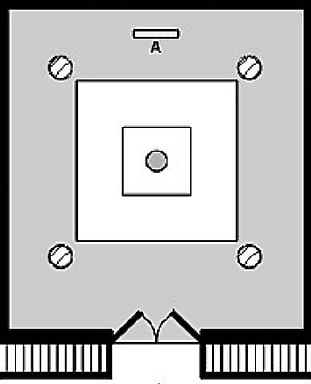| Erebuni Museum |
|
| |
|
| Section
13
13A. Decorative Bronze Shield (wall above figurines). Made from 30 kilograms of bronze (about 64 pounds), the shield's diameter is 70 cm to 1 meter. The shield is one of many that hung on the walls of the temple to Khaldi. 13B. Ceramic Vessels. 13C. Boxes with carved covers. On the third pedestal are two stone boxes with carved coverings. One cover depicts sun rays, the other has a ring of carved lions. 13D. Egyptian Amulet, on the pedestal below Khaldi, made of bronze. Urartu traded with Egypt, and this amulet would have been accepted as a good luck charm, possibly belonging to an Egyptian settler in Erebuni. 13E. Small bronze statuettes of Teisheba and Arubani. Teisheba was the god of war, Arubani the goddess of fertility, wife to Khaldi. 13F. Bronze Musical Bowl. Musical bowls or bells of various shapes were found during excavations. Used in religious or formal rites, the varying sizes create a startling ringing sound when struck together or in sequence. A
brass bell and Argishti stamp are located in small cases below the
musical bowl. Section 14 14A. Bone Amulets. Amulets were worn by both sexes, though this type was used primarily by men to ward off evil on expeditions and in battle. 14B. Jewelry includes necklaces of agate, obsidian and amber and ear-rings. Marble Wall Hanger 14C. Small Ceramic Figure. 14D. 4 Bronze Tureens with inscriptions to King Menuas in cuneiform. 14E. Four Stone fragment drawings on blue stone. Three are animal figures, while the fourth is in a geometric pattern. The right animal drawing represents a horse (religious icon), the left a bull image (everyday life scene). The style is unique for combining Mesopotamian and Mycanaean imagery. 14F. Amulet. 14G. Coin from Augustus Caesar imprints (2 AD) and Militian Coins. Urartu continued as a small military outpost until the end of the Roman period, and many artifacts from later periods were found at the site. These represent a few. 14H. Sarduri II Helmet: Thought to be worn by Sarduri himself in battle, the helmet is an embossed bronze and metal helmet with unique iconography. The picture on the wall above highlights the details on the helmet. On the front of the helmet has a hammered picture on three levels. The central image is of two gods taking fruit from a "tree of life". Eight (four on each side) snakes with lion heads curve over the entire design (guarding against evil spirits/souls). The back of the helmet shows a picture of Urartian soldiers in chariots or on horses. 14I. (on wooden stands): a) Argishti I Arrow and Stamp, arrow has inscription in cuneiform. b) Necklace with stone beads c) Necklace strands d) clothing buttons e) wooden box fragments and bone wall hanger f) Bronze necklaces and rings g)
Necklaces, stone beads and bronze amulet Picture on the wall shows scenes from religious and everyday life as reconstructed from excavators. 15A. Bronze buckle from belt and Iron Sword 15B. 3 Drinking Vessels made into the likeness of a horse, man riding a horse and a small bull. From the 5th-4th centuries BC, the vessels are identical to others found during the Urartian period, showing a strong cultural link that continued in the early Armenian period. 15C. Bronze shields. The shields were mostly ornamental, once decorating the walls of the temple to Khaldi. Persians converted the temple to a pre-Zoroastrian temple in the 5th century BCE. These shields were found at Karmir Blur and Armavir. 15D. Argishti I Drinking Cup. Cuneiform inscription circles below a tower with spear rising from it. The symbols of the tower with a spear have become Yerevan's coat of arms. |
|
| |
| Section
16
Central Courtyard. The courtyard in the center of the museum is a reconstruction of the palace courtyard at the excavation site. The first use of peristyle (using columns to surround a building or enclose a central court) found in the eastern Urartian empire, the courtyard provided covered walkways to connecting rooms in the palace and the temple of Sushi, worshipped by Argishti and Sarduri. The covered ground suggests the polished stones used in the palace, with a central hole for fires. 16A. "Argishti II" Khachkar. Found at Tanahat Vank near Sissian, this cuneiform stone dedicated to Argishti II, was carved on one side into a khachkar in the eleventh century AD. Cuneiform inscriptions can be found on the surface of the cross. |

|